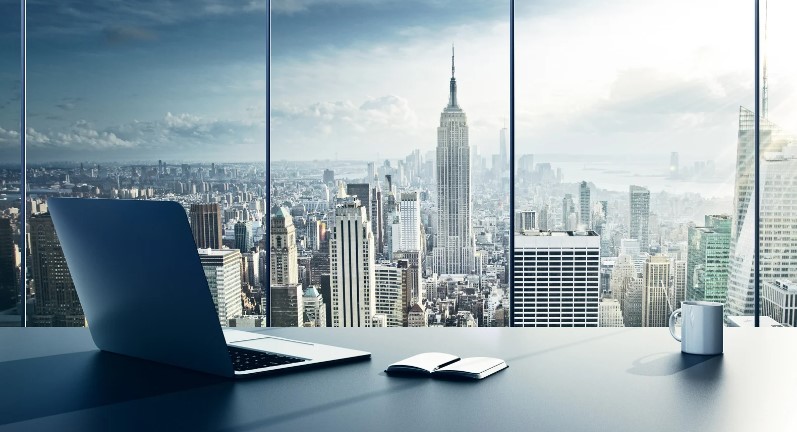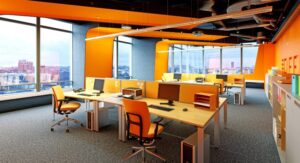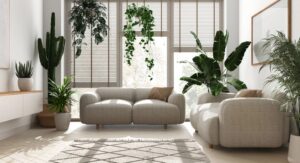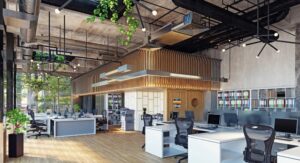
Office Design Trends for Hybrid Workplaces
Hybrid working is here to stay, with many businesses and their employees seeing the benefits since the Covid pandemic. Hybrid working entails employees conducting their work both at home and in the office, with many preferring the freedom it gives them to have a better work-life balance.
However, just because workers now have the advantage of working from home it doesn’t mean that the office environment should be neglected. No, in fact office design plays a pivotal role in establishing a productive environment for employees to succeed and, in turn, the success of the business.
So, what are the top office design trends to implement for hybrid workplaces? Read on to discover what solutions work and which trends can take your office from your boring bog-standard environment to a workplace that people want to occupy.
Top 5 Office Design Trends for Hybrid Workplaces
1. Flexible Workstations

One of the first key office design trends is the implementation of flexible workstations.
Much like the flexibility of certain days at home and some in the office, these adaptable spaces allow staff to move between different work environments based on their tasks. Many offices make use of quiet spaces for much needed focus and collaborative areas for team discussions.
Modular furniture, adjustable stations like standing desks and hot desking are trends that all support flexibility, encouraging both creativity and flexibility.
As businesses continue to embrace hybrid models, designing adaptable workstations is essential to cater to in-office and remote workers when they return for specific jobs or meetings.
“A well-executed office fit out plays a crucial role in supporting hybrid work arrangements, providing adaptable spaces that cater to diverse working styles,” says Neil Davies, Director of Vanguard Contracts. “By allowing flexibility in how spaces are used, businesses can maximise productivity and ensure that employees have the right environment to suit their tasks.”
2. Collaborative Spaces
While many people benefit from working from home in their own fortress of solitude, sometimes communicating and collaborating is limited by the likes of Zoom and Microsoft Teams.
Positive office interior design includes collaborative spaces designed to facilitate teamwork, brainstorming and creative problem-solving, ensuring employees truly connect when they’re in the office.
Open-plan office designs with modular seating, glass-enclosed meeting rooms and interactive digital boards create a seamless flow between in-person and remote workers. Think about having dedicated rooms with these collaborative solutions that foster a sense of inclusion, where everyone, regardless of location, can engage in meaningful teamwork.
3. Incorporating Biophilic Design

Good office design wouldn’t be complete without a few plants and greenery. Natural elements in an office environment are known to improve productivity and well-being.
Biophilic design doesn’t just involve plant life; it involves utilising natural light and outdoor views to create a calming and inviting atmosphere. Even a natural colour scheme for your office interior design can enhance the overall mood, or why not try living walls or strategically placed plant life.
Make use of large windows to allow plenty of light to enter workspaces and create an office that is a welcoming space for workers that might not be in every day.
4. Technology Integration
As part of office fit outs, technology is a vital resource in bridging the gap between remote and in-office employees.
Video conferencing tools implemented in smart meeting rooms, wireless charging stations and cloud-based systems for administration allow for quick and easy access to resources and communication, and there are various technological options to suit individual preferences such as touchless technology to promote a more hygienic work environment.
The latest technology for an office will enable employees to stay connected and productive wherever they are.
5. Wellness-Focused Design

While all these office design trends promote employee wellness, there are many other easy solutions that prioritise well-being.
- Ergonomic Furniture: Comfortable chairs that promote good posture, sofa areas for relaxation and ergonomic technology, such as computer mouses, all enable employee wellness.
- Quiet Zones: If you have the space, create designated quiet zones that can be used by employees for focused tasks or as a simple retreat for them to recharge and relax.
- Encourage Movement: Many offices focus on the trend of encouraging movement with decorative paths and standing desks. These elements help reduce fatigue and stress, promoting both physical and mental well-being.
These are just some of the office interior design trends that prioritise employee wellness, with others including natural lighting, access to outdoor areas and technology such as air purification systems. By focusing on wellness in office design, companies can support their employees’ long-term productivity and satisfaction by being both comfortable at home and when back in the office.
Conclusion
With hybrid workplaces now shaping the future of how people work, office design is critical in supporting the transition. By embracing office design trends such as flexible workstations, collaborative spaces, biophilic design, technology integration and wellness-focused layouts, businesses can craft an environment that meets the needs of a diverse and dynamic workforce.
With detailed planning, every size and type of office can enhance productivity and foster a sense of community, ensuring employees feel supported and engaged, whether they’re working remotely or in the office.
Author Profile
- Blogger by Passion | Contributor to many Business Blogs in the United Kingdom | Fascinated to Write Blogs in Business & Startup Niches |
Latest entries
 BusinessMarch 26, 2025eCommerce Strategies to Reduce Returns You Can Leverage Today
BusinessMarch 26, 2025eCommerce Strategies to Reduce Returns You Can Leverage Today BusinessMarch 11, 2025The Future of Pharmaceutical Packaging
BusinessMarch 11, 2025The Future of Pharmaceutical Packaging BusinessFebruary 28, 2025SaaS Client Onboarding Challenges and How to Tackle Them?
BusinessFebruary 28, 2025SaaS Client Onboarding Challenges and How to Tackle Them? BusinessFebruary 28, 2025Interim Finance Managers: Why Hiring Them for your Business?
BusinessFebruary 28, 2025Interim Finance Managers: Why Hiring Them for your Business?

